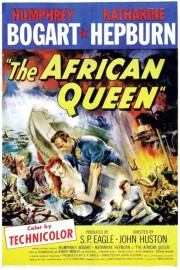The African Queen
About halfway through John Huston’s “The African Queen,” it occurred to me that, since it WAS, after all, my “Movie a Week” selection, perhaps I should actually be reviewing it. I was having too much fun watching it, however, which in all fairness, was the last thing I expected from this classic film.
Having seen a few of Huston and Humphrey Bogart’s films together already, I’ll admit that I didn’t expect to see a film that was all about entertaining its viewer. If you’ve seen previous collaborations like “The Maltese Falcon,” “Key Largo,” and especially, “The Treasure of the Sierra Madre,” you’ll understand where I’m coming from. But Bogart and Huston were entering a different phase of their collaboration; after all, up next was an even more unlikely effort in the wicked comedy, “Beat the Devil.” Based on the novel by C.S. Forester, “The African Queen” doesn’t look at the dark soul of film noir like earlier films did, but is, instead, a joyous adventure movie about two people traveling an African river, trying to escape the perils of the just-started WWI. That alone sets it apart among either the actor’s or director’s other work.
Bogart won his only Academy Award for his performance as Charlie Allnut, a drunken sailor on the African river who delivers mail in his boat, the African Queen. Two of the people he delivers to are Rose Sayar (Katherine Hepburn) and her brother, Samuel (Robert Morley), who are British missionaries trying to bring Christianity to the natives. The year is 1914, and not long after the film starts, the Germans come to the village where the Sayar’s are, burning the huts, and causing insanity in Samuel, who later dies. Allnut makes his way to the village to check on things, and finds Rose alone. They set off to go up the river, and escape capture from the Germans, and maybe, help the war effort as well.
One of the great things about Huston as a filmmaker was his ability to boil down each film (at least, each one I’ve seen) to its essence. The results would normally be overly simplistic, but Huston, here working with co-writer James Agee, understood how to bring depth to his stories without bogging them down narratively. Films like “Falcon,” “Sierra Madre,” “The Dead,” and “The African Queen” don’t get overly complicated in terms of the story, but are given depth by the characters, which Huston and his actors imbue with intrigue that isn’t always obvious at first, but becomes clear by the time the film ends. Helping Huston here are performances by Bogart and Hepburn, two of the great actors of any generation, who start with characters that play to our expectations of the personalities playing them, but grow closer, and more interesting, with each mile down the river they ride. Make no mistake– this is definitely a two-person show (none of the rich ensembles that peppered “Falcon” or “Beat the Devil”), and Bogart and Hepburn are worth every minute of the 105 minutes we spend with them in this romantic, exciting adventure.










